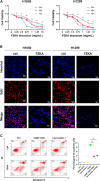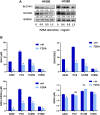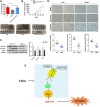GPX4 Plays a Crucial Role in Fuzheng Kang'ai Decoction-Induced Non-Small Cell Lung Cancer Cell Ferroptosis
- PMID: 35496303
- PMCID: PMC9043103
- DOI: 10.3389/fphar.2022.851680
GPX4 Plays a Crucial Role in Fuzheng Kang'ai Decoction-Induced Non-Small Cell Lung Cancer Cell Ferroptosis
Abstract
Background: Fuzheng Kang'ai decoction (FZKA) has been widely used to treat Non-Small Cell Lung Cancer (NSCLC) patients in China for decades, showing definitively curative effects in clinic. Recently, we found that FZKA could induce NSCLC cell ferroptosis, another type of programmed cell death (PCD), which is totally different from cell apoptosis. Therefore, in the present study, we aim to discover the exact mechanism by which FZKA induces NSCLC cell ferroptosis, which is rarely studied in Traditional Chinese Medicine (TCM). Methods: Cell proliferation assay were performed to detect the cell viability. Cell ferroptosis triggered by FZKA was observed by performing lipid peroxidation assay, Fe2+ Ions assay, and mitochondrial ultrastructure by transmission electron microscopy. Ferroptosis inhibitors including liproxstatin-1 and UAMC 3203 were used to block ferroptosis. The ratio of GSH/GSSG was done to measure the alteration of oxidative stress. Western blot and qRT-PCR were carried out to detect the expression of solute carrier family 7 member 11 (SLC7A11), solute carrier family 3 member 2 (SLC3A2) and glutathione peroxidase 4 (GPX4) at protein and mRNA levels, respectively. Lentivirus transfection was performed to overexpress GPX4 stably. Animal model was done to verify the effect of FZKA-induced ferroptosis in NSCLC in vivo and immunohistochemistry was done to detect the expression of SLC7A11, SLC3A2 and GPX4 at protein level. Results: First of all, in vitro experiments confirmed the inhibition effect of FZKA on NSCLC cell growth. We then, for the first time, found that FZKA induced NSCLC cell ferroptosis by increasing lipid peroxidation and cellular Fe2+ Ions. Moreover, characteristic morphological changes of NSCLC cell ferroptosis was observed under transmission electron microscopy. Mechanistically, GPX4, as a key inhibitor of lipid peroxidation, was greatly suppressed by FZKA treatment both at protein and mRNA levels. Furthermore, system xc- (SLC7A11 and SLC3A2) were found to be suppressed and a decreased GSH/GSSG ratio was observed at the same time when treated with FZKA. Notably, overexpressing GPX4 reversed the effect of FZKA-induced NSCLC cell ferroptosis significantly. Finally, the above effect was validated using animal model in vivo. Conclusion: Our findings conclude that GPX4 plays a crucial role in FZKA-induced NSCLC cell ferroptosis, providing a novel molecular mechanism by which FZKA treats NSCLC.
Keywords: FZKA; GPX4; NSCLC; TCM; ferroptosis.
Copyright © 2022 Zhao, Yang, Sheng, Tang, Han, Wang and Wu.
Conflict of interest statement
The authors declare that the research was conducted in the absence of any commercial or financial relationships that could be construed as a potential conflict of interest.
Figures







Similar articles
-
Fuzheng Kang-Ai decoction enhances the effect of Gefitinib-induced cell apoptosis in lung cancer through mitochondrial pathway.Cancer Cell Int. 2020 May 24;20:185. doi: 10.1186/s12935-020-01270-3. eCollection 2020. Cancer Cell Int. 2020. PMID: 32489321 Free PMC article.
-
Chinese herbal medicine Fuzheng Kang-Ai decoction sensitized the effect of gefitinib on inhibition of human lung cancer cells through inactivating PI3-K/Akt -mediated suppressing MUC1 expression.J Ethnopharmacol. 2016 Dec 24;194:918-929. doi: 10.1016/j.jep.2016.10.077. Epub 2016 Oct 28. J Ethnopharmacol. 2016. PMID: 27989877
-
Inhibition of SLC7A11-GPX4 signal pathway is involved in aconitine-induced ferroptosis in vivo and in vitro.J Ethnopharmacol. 2023 Mar 1;303:116029. doi: 10.1016/j.jep.2022.116029. Epub 2022 Dec 9. J Ethnopharmacol. 2023. PMID: 36503029
-
A review on the research progress of traditional Chinese medicine with anti-cancer effect targeting ferroptosis.Chin Med. 2023 Oct 13;18(1):132. doi: 10.1186/s13020-023-00838-1. Chin Med. 2023. PMID: 37833746 Free PMC article. Review.
-
System Xc -/GSH/GPX4 axis: An important antioxidant system for the ferroptosis in drug-resistant solid tumor therapy.Front Pharmacol. 2022 Aug 29;13:910292. doi: 10.3389/fphar.2022.910292. eCollection 2022. Front Pharmacol. 2022. PMID: 36105219 Free PMC article. Review.
Cited by
-
Insight into the potential role of ferroptosis in neurodegenerative diseases.Front Cell Neurosci. 2022 Oct 27;16:1005182. doi: 10.3389/fncel.2022.1005182. eCollection 2022. Front Cell Neurosci. 2022. PMID: 36385946 Free PMC article. Review.
-
The molecular and metabolic landscape of ferroptosis in respiratory diseases: Pharmacological aspects.J Pharm Anal. 2025 Jan;15(1):101050. doi: 10.1016/j.jpha.2024.101050. Epub 2024 Jul 24. J Pharm Anal. 2025. PMID: 40034685 Free PMC article. Review.
-
The role of glutathione peroxidase 4 in the progression, drug resistance, and targeted therapy of non-small cell lung cancer.Oncol Res. 2025 Mar 19;33(4):863-872. doi: 10.32604/or.2024.054201. eCollection 2025. Oncol Res. 2025. PMID: 40191731 Free PMC article. Review.
-
Unveiling the role of RhoA and ferroptosis in vascular permeability: Implications for osteoarthritis.Int J Mol Med. 2024 Oct;54(4):86. doi: 10.3892/ijmm.2024.5410. Epub 2024 Aug 12. Int J Mol Med. 2024. PMID: 39129277 Free PMC article.
-
Ferroptosis and its emerging role in esophageal cancer.Front Mol Biosci. 2022 Sep 27;9:1027912. doi: 10.3389/fmolb.2022.1027912. eCollection 2022. Front Mol Biosci. 2022. PMID: 36237575 Free PMC article. Review.
References
LinkOut - more resources
Full Text Sources

